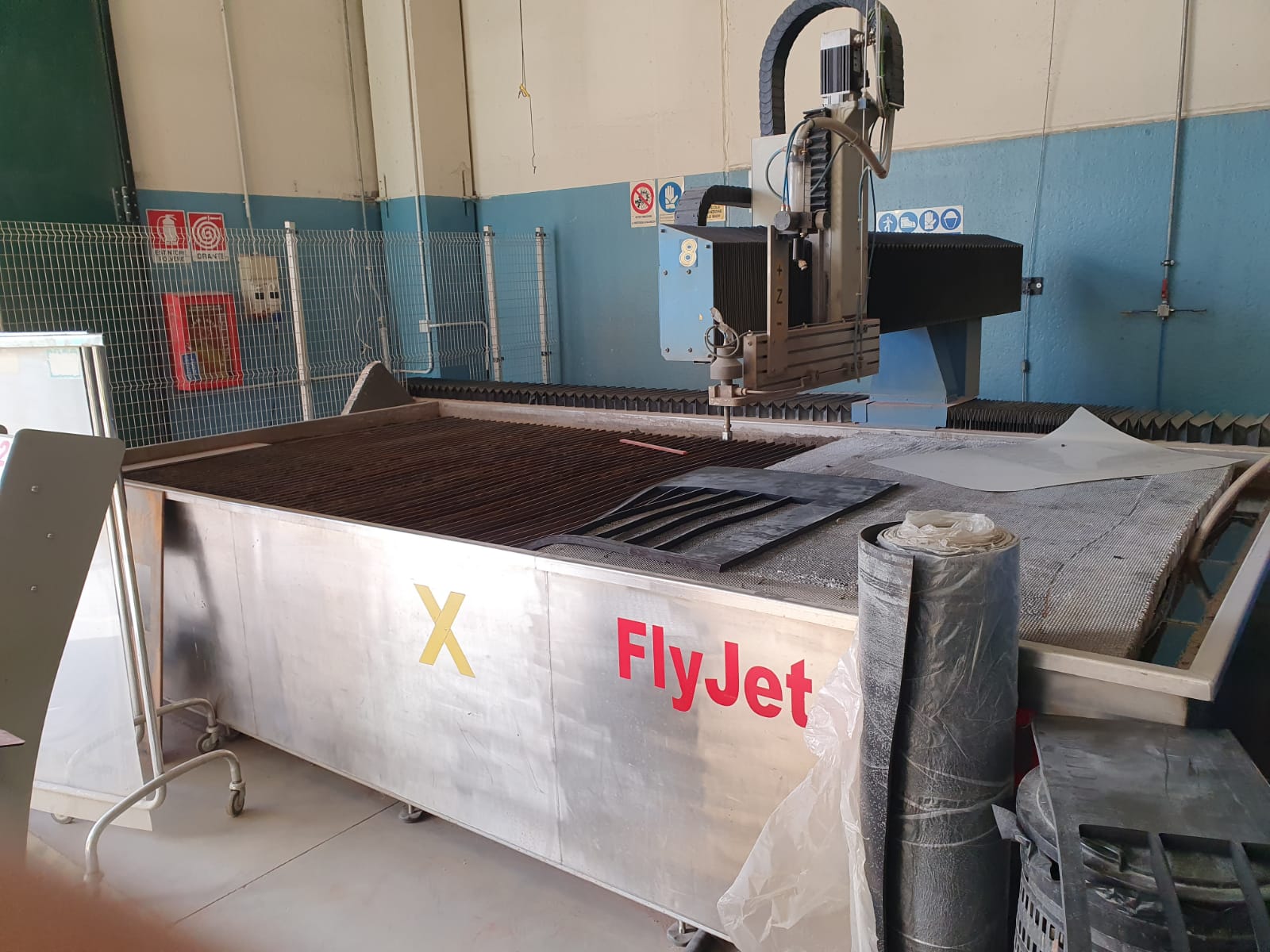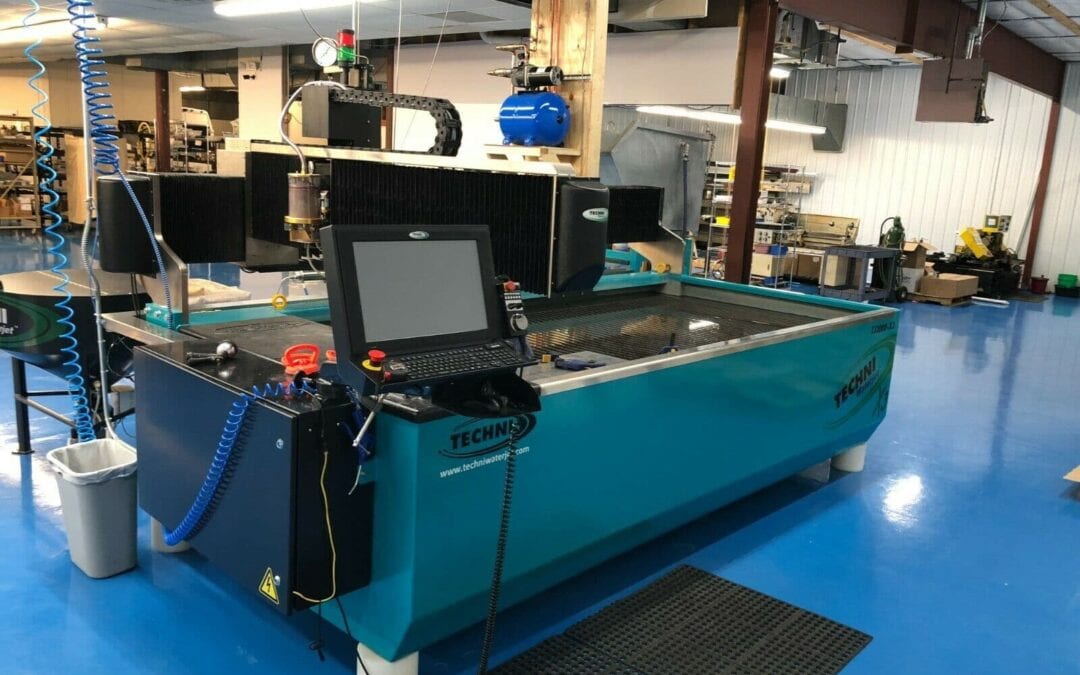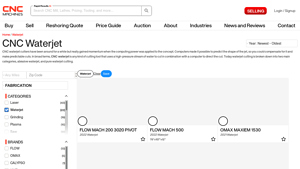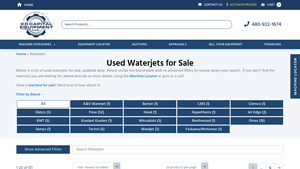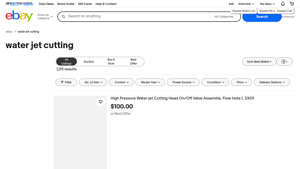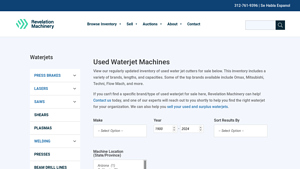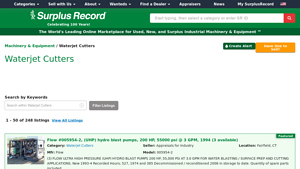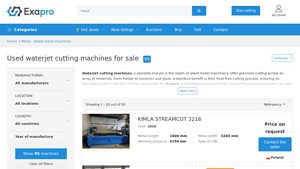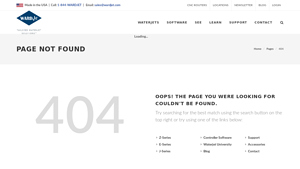Used Waterjet Guide: Type, Cost, Top List…
Introduction: Navigating the Global Market for used waterjet
Navigating the complex landscape of sourcing used waterjet cutting machines can pose significant challenges for international B2B buyers. With varying technologies, such as abrasive versus pure waterjet cutting, and the need to assess machine condition and performance, making an informed purchasing decision is crucial. This comprehensive guide serves as a valuable resource, detailing the different types of used waterjet machines available, their applications across various industries, and best practices for supplier vetting. By understanding the costs associated with ownership and operation, buyers from regions like Africa, South America, the Middle East, and Europe—including countries like Brazil and Saudi Arabia—can mitigate risks and enhance their procurement strategies.
In this guide, we will explore the essential factors influencing the purchase of used waterjet machines, including maintenance considerations, technological advancements, and the importance of compatibility with existing systems. Furthermore, we will provide insights into the market trends shaping the used waterjet landscape, empowering buyers to make choices that align with their operational needs and budget constraints. By the end of this guide, B2B buyers will be equipped with the knowledge necessary to navigate the global market confidently, ensuring they secure high-quality, cost-effective solutions tailored to their specific requirements.
Understanding used waterjet Types and Variations
| Type Name | Key Distinguishing Features | Primary B2B Applications | Brief Pros & Cons for Buyers |
|---|---|---|---|
| Abrasive Waterjet | Uses a mixture of water and abrasive materials | Metal fabrication, stone cutting, aerospace | Pros: Versatile for hard materials; faster cutting. Cons: Higher operational costs due to abrasives. |
| Pure Waterjet | Employs only high-pressure water for cutting | Soft materials like foam, rubber, and plastics | Pros: Lower operational costs; minimal material alteration. Cons: Limited to softer materials. |
| Direct Drive Waterjet | Powered by a crankshaft-driven pump | General cutting applications | Pros: Simpler design; lower initial cost. Cons: Higher maintenance requirements. |
| Intensifier Waterjet | Utilizes hydraulic rams for water pressurization | Heavy-duty cutting tasks | Pros: Lower maintenance; longer lifespan. Cons: Higher initial investment. |
| Multi-Head Waterjet | Features multiple cutting heads for increased efficiency | High-volume production settings | Pros: Increased throughput; reduced cutting time. Cons: Higher complexity and potential for more downtime. |
What Are the Characteristics of Abrasive Waterjets?
Abrasive waterjet cutting machines are designed to cut through tough materials by combining high-pressure water with abrasive substances, typically garnet. This method is highly effective for applications in metal fabrication, stone cutting, and the aerospace industry, where precision and speed are critical. Buyers should consider the operational costs associated with abrasives and the need for regular maintenance of the cutting heads, which can wear out over time.
How Do Pure Waterjets Differ in Use?
Pure waterjet machines operate solely on high-pressure water, making them suitable for softer materials such as foam, rubber, and certain plastics. This type of cutting is advantageous for applications where material integrity is crucial, as it avoids thermal distortion. B2B buyers should assess their material requirements and the potential for lower operational costs when considering pure waterjets, but they must also recognize the limitations in cutting harder materials.
What Are the Advantages of Direct Drive Waterjets?
Direct drive waterjets utilize a simpler mechanism powered by a crankshaft-driven pump. They are typically lower in initial cost, making them attractive for businesses with budget constraints. However, they may require more frequent maintenance, which could lead to increased long-term costs. Companies should evaluate their cutting needs and maintenance capabilities when deciding on this type.
Why Choose Intensifier Waterjets?
Intensifier waterjets leverage hydraulic rams to achieve higher water pressures, making them suitable for heavy-duty cutting tasks. They require less maintenance compared to direct drive systems, which can lead to lower long-term operational costs. However, the higher initial investment may be a consideration for budget-conscious buyers. Businesses focused on high-volume, precision cutting should weigh these factors carefully.
What Are the Benefits of Multi-Head Waterjets?
Multi-head waterjets are equipped with several cutting heads, allowing for simultaneous cutting of multiple parts. This feature significantly increases throughput and reduces overall cutting time, making them ideal for high-volume production environments. However, the complexity of these systems can lead to higher maintenance requirements and potential downtime. Companies should assess their production volume and operational capabilities to determine if this investment aligns with their business goals.
Key Industrial Applications of used waterjet
| Industry/Sector | Specific Application of used waterjet | Value/Benefit for the Business | Key Sourcing Considerations for this Application |
|---|---|---|---|
| Aerospace | Cutting complex components for aircraft | High precision and ability to cut hard materials without heat distortion | Ensure compatibility with specific materials and tolerances required in aerospace engineering |
| Automotive | Manufacturing parts such as body panels and frames | Efficient cutting of various materials, including metals and composites | Assess machine capacity to handle diverse materials and thicknesses used in automotive manufacturing |
| Construction and Architecture | Creating intricate designs in stone and glass | Ability to produce complex shapes with minimal waste | Verify the machine’s cutting capabilities for specific materials like granite or tempered glass |
| Metal Fabrication | Custom fabrication of metal parts and structures | Versatile cutting options for different metal types and thicknesses | Consider the pump type (direct drive vs. intensifier) based on production needs and maintenance capabilities |
| Signage and Graphics | Producing customized signs and displays | Enhances creativity with intricate designs and cuts | Look for machines that can handle various substrates, including plastics and metals, for signage production |
How is Used Waterjet Applied in Aerospace Manufacturing?
In the aerospace industry, used waterjet cutting machines are essential for producing complex components such as turbine blades, wing structures, and other precision parts. The non-thermal cutting process prevents heat distortion, ensuring that the integrity of high-strength materials is maintained. Buyers in this sector must ensure that the waterjet machines can accommodate specific tolerances and materials, such as titanium or aluminum alloys, which are commonly used in aircraft manufacturing.
What Role Does Used Waterjet Play in Automotive Manufacturing?
Automotive manufacturers leverage used waterjet technology for cutting body panels, frames, and other critical components. The ability to handle various materials, including metals and composites, allows for efficient production processes. B2B buyers in this field should focus on sourcing machines that can manage diverse thicknesses and provide high cutting speeds, as well as those equipped with multiple cutting heads to enhance productivity.
How is Used Waterjet Beneficial for Construction and Architecture?
In construction and architecture, used waterjet machines are utilized for cutting intricate designs in materials like stone, glass, and metals. This technology enables architects and builders to achieve complex shapes while minimizing waste, which is crucial for high-end projects. Buyers should consider machines with the capability to cut specific materials and ensure they have the right software for design integration.
Why is Used Waterjet Important in Metal Fabrication?
Metal fabrication relies heavily on used waterjet cutting for custom parts and structures. The versatility of waterjet technology allows fabricators to cut through various metal types, including steel and aluminum, with precision. When sourcing used waterjet machines, buyers must evaluate the pump type—direct drive or intensifier—based on their production volume and maintenance preferences, as these factors significantly impact operational costs.
How Does Used Waterjet Enhance Signage and Graphics Production?
Used waterjet cutting is increasingly popular in the signage and graphics industry for producing customized signs and displays. The ability to create intricate designs and cuts on various substrates, such as plastics and metals, enhances creativity and product differentiation. Buyers should look for machines with versatile cutting capabilities and software that integrates easily with design tools to streamline the production process.
3 Common User Pain Points for ‘used waterjet’ & Their Solutions
Scenario 1: Uncertainty About Machine Condition and Performance
The Problem:
When purchasing a used waterjet, many B2B buyers face the daunting task of evaluating the machine’s actual condition and performance capabilities. This uncertainty can lead to significant financial risk if the machine has hidden defects or if it does not meet the operational standards required for their specific applications. Buyers may worry about the machine’s maintenance history, whether it has undergone any major repairs, and how its performance might compare to new models. This fear is compounded by the potential for costly downtime if the machine fails to perform as expected after purchase.
The Solution:
To mitigate these concerns, buyers should conduct thorough due diligence before finalizing a purchase. Start by requesting detailed maintenance records and performance reports from the seller. Engaging a third-party technician to perform an inspection can provide an unbiased assessment of the machine’s condition, including checks on critical components such as the pump, cutting head, and software functionalities. Additionally, buyers should ask for a demonstration of the machine in operation, ideally cutting materials similar to what they will be working with. This hands-on experience can help ensure that the machine meets their specific cutting needs and performance standards.
Scenario 2: Complications with Sourcing Replacement Parts
The Problem:
Another prevalent issue faced by B2B buyers of used waterjet machines is the challenge of sourcing replacement parts. As machines age, finding compatible components can become increasingly difficult, especially if the original manufacturer has ceased production or if the model is discontinued. This situation can lead to extended downtimes and lost revenue as buyers scramble to locate necessary parts, often at inflated prices or with long lead times.
The Solution:
To address this pain point, buyers should prioritize purchasing from reputable suppliers who offer a robust inventory of replacement parts or have established partnerships with manufacturers. Before purchasing a used waterjet, it is advisable to confirm the availability of essential components and consumables, such as nozzles, pumps, and abrasives. Buyers can also consider joining user forums or industry groups where they can network with other operators of similar machines to share resources and recommendations for parts suppliers. Establishing a good relationship with a local service provider who specializes in waterjet technology can further ensure timely access to parts and maintenance support.
Scenario 3: Lack of Technical Support and Training Resources
The Problem:
Buyers often find themselves lacking adequate technical support and training resources after acquiring a used waterjet. This can be particularly challenging for organizations that may not have in-house expertise or staff experienced in operating and maintaining waterjet machinery. The absence of proper training can lead to inefficient machine use, increased wear and tear, and even safety hazards in the workplace.
The Solution:
To overcome this issue, buyers should seek out suppliers that offer comprehensive training programs and ongoing technical support as part of the purchase agreement. Prior to completing a transaction, inquire about training resources that can be provided, such as manuals, online tutorials, or on-site training sessions. Additionally, buyers can invest in a service contract that includes regular maintenance and support from knowledgeable technicians. By fostering a partnership with the seller and leveraging their expertise, organizations can ensure that their staff is well-trained and confident in operating the waterjet, thereby maximizing productivity and minimizing risks associated with improper usage.
Strategic Material Selection Guide for used waterjet
What Are the Key Properties of Common Materials Used in Waterjet Cutting?
Waterjet cutting technology is versatile and can handle a wide range of materials. Understanding the properties and compatibility of these materials is crucial for B2B buyers, especially when selecting used waterjet machines. Below, we analyze four common materials: metals, stone, glass, and plastics.
Metals: Steel and Aluminum
Key Properties:
Metals like steel and aluminum are known for their high strength-to-weight ratios and excellent durability. Steel can withstand high temperatures and pressures, making it suitable for heavy-duty applications. Aluminum, while lighter, offers good corrosion resistance and is easier to machine.
Pros & Cons:
Steel is highly durable and cost-effective, but it can be challenging to cut due to its density. Aluminum is easier to cut and offers a better finish but is generally more expensive. Both materials are widely used in construction and manufacturing.
Impact on Application:
The choice of metal affects the cutting speed and the type of abrasive used. For example, steel may require a coarser abrasive for effective cutting.
Considerations for International Buyers:
Compliance with standards like ASTM or DIN is essential, especially in regions like Europe and the Middle East. Buyers should ensure that the used waterjet machine can handle the specific grades of steel or aluminum they intend to work with.
Stone: Granite and Marble
Key Properties:
Granite and marble are hard materials known for their aesthetic appeal and durability. They can withstand high pressure but require specialized abrasives for effective cutting.
Pros & Cons:
These stones offer excellent durability and are ideal for countertops and flooring. However, they can be costly and may require additional processing to achieve a polished finish.
Impact on Application:
Waterjet cutting allows for intricate designs in stone without generating heat, which can cause cracking. This makes it suitable for artistic applications.
Considerations for International Buyers:
Buyers should be aware of local regulations regarding stone extraction and processing. Compliance with environmental standards is crucial, particularly in regions with strict regulations.
Glass: Tempered and Laminated Glass
Key Properties:
Glass is a brittle material that requires careful handling. Tempered glass is heat-treated for strength, while laminated glass consists of multiple layers for safety.
Pros & Cons:
Waterjet cutting offers a clean edge and minimizes the risk of chipping. However, the brittleness of glass can lead to breakage during cutting, making it less forgiving than other materials.
Impact on Application:
Waterjet cutting is ideal for creating custom shapes and sizes in glass, making it popular in architecture and design.
Considerations for International Buyers:
International buyers must ensure compliance with safety standards for glass products, which can vary significantly across regions. Understanding local market preferences for glass types is also essential.
Plastics: Acrylic and Polycarbonate
Key Properties:
Plastics like acrylic and polycarbonate are lightweight and versatile. They can withstand moderate temperatures but may warp under extreme heat.
Pros & Cons:
These materials are easy to cut and shape, making them suitable for a variety of applications, from signage to protective barriers. However, they can be more expensive than traditional materials like wood or metal.
Impact on Application:
Waterjet cutting allows for precise cuts without melting the edges, which is crucial for maintaining clarity in acrylic applications.
Considerations for International Buyers:
Buyers should consider the availability of specific plastic grades in their region and ensure that the used waterjet machine is compatible with the material’s properties.
Summary Table of Material Selection for Used Waterjet
| Material | Typical Use Case for used waterjet | Key Advantage | Key Disadvantage/Limitation | Relative Cost (Low/Med/High) |
|---|---|---|---|---|
| Metals (Steel, Aluminum) | Manufacturing, construction, automotive | High durability and strength | Dense materials can be challenging to cut | Medium |
| Stone (Granite, Marble) | Countertops, flooring, artistic designs | Excellent aesthetic appeal and durability | High cost and requires polishing | High |
| Glass (Tempered, Laminated) | Architecture, custom shapes, design | Clean cuts with minimal chipping | Brittle; risk of breakage | Medium |
| Plastics (Acrylic, Polycarbonate) | Signage, protective barriers | Easy to cut; precise edges | Can be more expensive than metals | Medium |
This strategic material selection guide provides essential insights for international B2B buyers looking to optimize their used waterjet cutting operations. Understanding the properties, advantages, and limitations of each material will enable informed decision-making and enhance operational efficiency.
In-depth Look: Manufacturing Processes and Quality Assurance for used waterjet
What Are the Main Stages in the Manufacturing Process of Used Waterjet Machines?
The manufacturing process of used waterjet machines encompasses several critical stages, ensuring that these systems meet high operational standards.
-
Material Preparation: This initial stage involves selecting high-quality raw materials, often steel or aluminum, that will form the structural components of the waterjet machine. Materials are inspected for defects, such as cracks or corrosion, before moving on to the next stage.
-
Forming: In this phase, the prepared materials undergo processes like cutting, bending, or machining to achieve the desired shapes. CNC (Computer Numerical Control) machines are frequently utilized to ensure precision. The forming stage is crucial, as inaccuracies can lead to significant issues down the line.
-
Assembly: Once the individual components are formed, they are assembled into the waterjet system. This includes integrating the pump, cutting head, and control systems. Each assembly is conducted under strict tolerances to guarantee that all parts fit together correctly, ensuring optimal performance.
-
Finishing: The final stage involves surface treatments and coatings that enhance durability and resistance to wear. This may include anodizing or painting. Finishing not only improves the aesthetic appeal but also extends the machine’s lifespan, which is particularly important for used equipment.
What Key Techniques Are Used in Manufacturing Waterjet Machines?
Various techniques are employed throughout the manufacturing process to ensure that used waterjet machines are reliable and efficient:
-
CNC Machining: This technology is pivotal in achieving high precision in the forming stage. CNC machines can produce complex shapes and maintain tight tolerances, essential for the accurate operation of waterjets.
-
Hydraulic Pressing: Used in the forming phase, hydraulic presses shape metal components under high pressure, ensuring structural integrity and uniformity.
-
Laser Cutting: Often utilized for cutting complex geometries, laser cutting offers high precision and can handle various materials. This technique is beneficial for components that require intricate designs.
-
Quality Welding: Strong welds are crucial for the assembly of waterjet machines. Techniques like TIG (Tungsten Inert Gas) welding are often employed to ensure strong joints without compromising the material’s properties.
How Is Quality Assurance Implemented in Waterjet Manufacturing?
Quality assurance (QA) is a fundamental aspect of the manufacturing process for used waterjet machines. Implementing a robust QA system ensures that the machines meet international standards and function optimally.
-
International Standards: Compliance with ISO 9001 is essential for manufacturers aiming to demonstrate quality management. This standard provides a framework for consistent quality in design, production, and service.
-
Industry-Specific Certifications: Certifications such as CE (Conformité Européenne) and API (American Petroleum Institute) are critical for machines intended for specific markets. These certifications indicate compliance with safety, health, and environmental regulations.
What Are the Key QC Checkpoints in Waterjet Manufacturing?
Quality control (QC) checkpoints are integrated throughout the manufacturing process to catch potential issues early:
-
Incoming Quality Control (IQC): At this stage, raw materials are inspected for quality before they enter the production process. This prevents substandard materials from affecting the final product.
-
In-Process Quality Control (IPQC): During manufacturing, periodic checks are performed to ensure that processes are within specified limits. This may involve monitoring dimensions, pressure settings, and other critical parameters.
-
Final Quality Control (FQC): Once assembly is complete, a comprehensive inspection is carried out. This includes testing the machine’s functionality, checking for leaks, and ensuring that all components operate as intended.
What Testing Methods Are Commonly Used for Waterjet Machines?
Multiple testing methods are utilized to ensure the reliability and performance of used waterjet machines:
-
Hydrostatic Testing: This test checks for leaks in the high-pressure components of the waterjet. The machine is filled with water and pressurized to verify that it can withstand operational pressures without leaking.
-
Performance Testing: Machines are run through various cutting scenarios to validate their performance. This includes assessing cutting speed, accuracy, and edge quality across different materials.
-
Functional Testing: This involves running the entire machine through its operational cycles to ensure that all systems work harmoniously, including the pump, CNC controls, and cutting head.
How Can B2B Buyers Verify Supplier Quality Control?
For international B2B buyers, particularly from regions like Africa, South America, the Middle East, and Europe, verifying supplier quality control is crucial:
-
Supplier Audits: Conducting audits of the manufacturing facility can provide insights into their QA processes. This allows buyers to assess the adherence to international standards and the effectiveness of their QC measures.
-
Requesting Quality Reports: Buyers should ask suppliers for documentation related to quality control, including inspection reports and certifications. These documents provide evidence of compliance with relevant standards.
-
Third-Party Inspections: Engaging independent third-party inspectors can help verify the quality of the used waterjet machines. This is especially important for buyers who are unable to visit the supplier’s facility.
What Are the QC and Certification Nuances for International Buyers?
When purchasing used waterjet machines from international suppliers, buyers must be aware of specific nuances related to QC and certifications:
-
Understanding Regional Standards: Different countries may have varying standards and regulations. Buyers should familiarize themselves with the requirements in their respective regions, such as the European Union’s CE marking or the API standards in the oil and gas sector.
-
Language Barriers: Documentation may be in a different language, which can lead to misunderstandings. It’s advisable to have access to translation services or to work with suppliers who can provide documentation in the buyer’s preferred language.
-
Logistics and Compliance: International shipping can introduce complexities regarding customs and compliance. Buyers must ensure that the machines meet the import regulations of their countries, which may include safety and environmental standards.
By understanding these manufacturing processes and quality assurance protocols, B2B buyers can make informed decisions when purchasing used waterjet machines, ultimately ensuring they acquire reliable and efficient equipment that meets their operational needs.
Practical Sourcing Guide: A Step-by-Step Checklist for ‘used waterjet’
In the competitive landscape of industrial machinery procurement, sourcing a used waterjet cutting machine requires meticulous planning and execution. This guide provides a structured checklist to help B2B buyers navigate the complexities of purchasing used waterjet equipment, ensuring informed decisions that align with operational needs and budget considerations.
Step 1: Define Your Technical Specifications
Before initiating the purchasing process, it is essential to clearly outline your technical requirements. This includes the type of waterjet cutting you need—whether abrasive or pure waterjet—as well as the materials you intend to cut.
– Consider factors such as:
– Maximum material thickness
– Desired cutting speed
– Required precision and tolerances
Step 2: Set Your Budget and Financial Parameters
Establishing a budget is critical when sourcing used machinery. This not only includes the initial purchase price but also ongoing operational costs such as maintenance, consumables, and potential upgrades.
– Take into account:
– Total cost of ownership
– Financing options available
– Potential resale value
Step 3: Research and Identify Reputable Suppliers
A thorough supplier evaluation is paramount. Look for vendors with a solid reputation in the used machinery market.
– Key actions include:
– Checking online reviews and testimonials
– Requesting company profiles and relevant certifications
– Inquiring about their after-sales support and warranty policies
Step 4: Inspect the Equipment Thoroughly
Never finalize a purchase without a comprehensive inspection of the used waterjet machine. This should ideally be done on-site to assess its condition and functionality.
– Focus on:
– The overall physical state, including any signs of wear or damage
– Operational tests to verify cutting capabilities
– Maintenance records to understand the machine’s history
Step 5: Verify Compliance and Safety Standards
Ensure that the used waterjet complies with local and international safety standards. This is crucial not only for legal compliance but also for the safety of your operators.
– Check for:
– Relevant certifications (e.g., ISO, CE)
– Safety features included in the machine
– Compatibility with local regulations
Step 6: Request Documentation and Support Information
Before making a commitment, request all relevant documentation. This includes manuals, service records, and parts availability.
– Documentation should cover:
– Original purchase details
– Maintenance history and any modifications made
– Availability of spare parts and technical support
Step 7: Negotiate Terms and Conditions
Once you’ve identified a suitable machine, engage in negotiations. This is your opportunity to secure the best price and favorable terms.
– Consider negotiating:
– Payment terms (e.g., installment options)
– Warranty period and conditions
– Delivery timelines and associated costs
Following these steps will empower B2B buyers to make informed decisions when sourcing used waterjet cutting machines, ultimately enhancing operational efficiency and ROI.
Comprehensive Cost and Pricing Analysis for used waterjet Sourcing
What Are the Key Cost Components in Sourcing Used Waterjets?
When sourcing used waterjet cutting machines, buyers must consider several key cost components that contribute to the overall investment. These components include:
-
Materials: The cost of materials can vary significantly depending on the type of waterjet technology (abrasive vs. pure waterjet) and the specific requirements of the cutting job. For instance, abrasive waterjets utilize garnet and other abrasives, which should be factored into the cost.
-
Labor: Labor costs encompass the wages for operators, technicians, and maintenance staff. Depending on the region, labor rates can differ, impacting the overall cost structure.
-
Manufacturing Overhead: This includes costs related to facilities, utilities, and administrative expenses. Understanding the overhead associated with the supplier can help buyers gauge the true cost of the equipment.
-
Tooling: Tooling costs can include the purchase of additional cutting heads or specialized attachments needed for specific applications. Custom tooling may be required for unique projects, affecting the overall cost.
-
Quality Control (QC): Ensuring that the used waterjet meets quality standards may involve additional costs related to testing and certification. This is particularly relevant for international buyers who may need to meet specific regulatory standards.
-
Logistics: Transportation and handling costs are significant, especially for international shipments. Buyers must account for shipping fees, insurance, and potential customs duties.
-
Margin: Suppliers will typically include a profit margin in their pricing. Understanding the market dynamics can help buyers negotiate better terms.
How Do Price Influencers Affect Used Waterjet Costs?
Several factors influence the pricing of used waterjet machines:
-
Volume/MOQ: Buyers looking to purchase multiple units often benefit from reduced pricing. Suppliers may offer discounts for bulk orders, which can lead to significant savings.
-
Specifications and Customization: Machines with advanced features or custom modifications typically command higher prices. Buyers should clearly define their needs to avoid paying for unnecessary upgrades.
-
Materials and Quality Certifications: The quality of materials used in the machine’s construction and the presence of certifications (ISO, CE) can impact pricing. Machines with higher quality components may come at a premium but often result in lower long-term operating costs.
-
Supplier Factors: The reputation and reliability of the supplier can influence pricing. Established suppliers may charge more, but they often provide better warranties and support, justifying the higher cost.
-
Incoterms: Understanding Incoterms (International Commercial Terms) is crucial for international buyers. They dictate who bears the cost and risk at various stages of the shipping process, affecting the final price.
What Are Effective Buyer Tips for Cost-Efficiency in Used Waterjet Sourcing?
For international B2B buyers, especially in regions like Africa, South America, the Middle East, and Europe, several tips can enhance cost-efficiency:
-
Negotiation Strategies: Leverage market research to negotiate better prices. Understanding local market rates can empower buyers during discussions.
-
Total Cost of Ownership (TCO): Consider not just the initial purchase price but also the long-term costs associated with maintenance, operation, and potential downtime. A slightly higher upfront cost may result in lower TCO if the machine is more reliable.
-
Pricing Nuances for International Transactions: Be aware of currency fluctuations, tariffs, and taxes that may affect the final price. Building relationships with local suppliers can also mitigate some of these costs.
-
Inspect Before You Buy: If possible, inspect the used waterjet machine in person or request detailed videos and reports. This can help ensure that the equipment meets your specifications and quality standards.
-
Request Multiple Quotes: Collecting quotes from various suppliers allows for price comparison, helping to identify the best deals available in the market.
Disclaimer on Indicative Prices
Prices for used waterjet machines can vary widely based on condition, specifications, and market demand. It is advisable to conduct thorough research and consult with multiple suppliers to obtain accurate pricing information tailored to specific needs.
Alternatives Analysis: Comparing used waterjet With Other Solutions
Exploring Alternative Solutions to Used Waterjet Technology
In the competitive landscape of industrial cutting solutions, B2B buyers often seek alternatives to ensure they make informed decisions. While used waterjet technology offers unique advantages, other cutting methods may provide better performance, cost-efficiency, or ease of use depending on specific operational needs. This section provides a comparative analysis of used waterjet technology against laser cutting and plasma cutting, two prominent alternatives.
| Comparison Aspect | Used Waterjet | Laser Cutting | Plasma Cutting |
|---|---|---|---|
| Performance | Excellent for various materials, including metals and composites; minimal heat-affected zone (HAZ). | High precision; best for thin materials; limited by reflective surfaces. | Fast cutting speed; effective for thicker metals but less precision on intricate designs. |
| Cost | Moderate initial investment; lower operating costs due to less material waste. | Higher initial investment; operational costs can vary significantly based on material. | Lower initial cost; higher consumable costs over time. |
| Ease of Implementation | Requires skilled operators; setup can be complex but manageable. | Easier to implement for trained operators; software compatibility can be a concern. | Generally easier to set up; requires specific electrical requirements. |
| Maintenance | Requires regular maintenance, especially for pumps; durable with proper care. | Lower maintenance needs; however, lens and mirrors require periodic replacement. | Generally low maintenance; needs routine checks on plasma torch and gas supply. |
| Best Use Case | Ideal for cutting thick, hard materials and intricate designs; versatile across industries. | Best for high-precision cutting of thin sheets; commonly used in electronics and automotive. | Suitable for heavy industrial applications where speed is prioritized over precision. |
Analyzing Laser Cutting: Advantages and Disadvantages
Laser cutting technology uses focused light to melt or vaporize materials, making it an excellent choice for precision work on thin materials. The advantages of laser cutting include high speed and accuracy, especially on metals like aluminum and stainless steel. However, it struggles with reflective materials and can create heat-affected zones, which may compromise the integrity of sensitive components. The initial investment for laser cutting equipment can be high, but operational costs may be lower due to reduced material waste.
Evaluating Plasma Cutting: Key Benefits and Drawbacks
Plasma cutting employs ionized gas to cut through conductive materials, making it ideal for thicker metals like steel and aluminum. Its primary advantage is the speed of cutting, which is significantly faster than both waterjet and laser methods. However, plasma cutting lacks the precision of laser cutting and is less effective for intricate designs. The initial cost of plasma cutting systems is typically lower, but ongoing consumable costs for electrodes and gases can accumulate, impacting overall budget considerations.
Conclusion: How to Select the Right Cutting Solution for Your Business
When choosing between used waterjet technology and its alternatives, B2B buyers must evaluate their specific operational needs, including material types, thicknesses, and desired precision. Used waterjet cutting is particularly advantageous for diverse materials and complex shapes, while laser cutting excels in precision for thin materials. Plasma cutting offers speed and efficiency for thicker materials but may sacrifice detail. Understanding these distinctions will enable businesses to select the most effective cutting solution that aligns with their production goals and budget constraints.
Essential Technical Properties and Trade Terminology for used waterjet
What Are the Essential Technical Properties of Used Waterjet Machines?
When considering the purchase of a used waterjet cutting machine, it’s crucial to understand its technical specifications. These properties can significantly impact the performance and suitability of the machine for specific applications.
1. Pump Output Pressure
The pump output pressure, typically measured in PSI (pounds per square inch), is a critical specification that indicates the machine’s cutting power. Common outputs range from 30,000 PSI to over 60,000 PSI. Higher pressure allows for cutting thicker materials and achieving finer detail, making it essential for industries such as aerospace and automotive manufacturing.
2. Cutting Area (Envelope Size)
The cutting area, or envelope size, defines the maximum dimensions of the material that can be processed. This measurement is usually expressed in inches (e.g., 5′ x 10′). Understanding the cutting area is vital for businesses that handle large sheets or require specific part sizes, ensuring the machine can accommodate their production needs.
3. Material Compatibility
Different waterjet machines are designed to handle various materials, including metals, plastics, glass, and stone. Knowing the machine’s material compatibility helps businesses determine if it can meet their operational requirements. For instance, machines that can cut hard materials like granite will be essential for construction or stone fabrication industries.
4. Type of Waterjet Cutting
Used waterjets can be categorized as either abrasive or pure waterjet machines. Abrasive waterjets incorporate materials like garnet to enhance cutting efficiency, making them suitable for tougher materials. Pure waterjets, on the other hand, are best for softer materials. Buyers should evaluate the types of materials they need to cut when selecting a machine type.
5. Control System
The control system of a waterjet machine dictates its operational ease and precision. CNC (Computer Numerical Control) systems are prevalent, allowing for automated cutting with high accuracy. A robust control system is crucial for ensuring repeatability and minimizing errors in production runs.
6. Maintenance Requirements
The maintenance needs of a waterjet cutter can vary significantly based on its design and components. Machines with direct drive pumps may require more frequent servicing than those with intensifier pumps. Understanding these requirements helps businesses budget for upkeep and downtime, ensuring smoother operations.
What Are Common Trade Terms Related to Used Waterjet Machines?
Familiarity with industry terminology can streamline the purchasing process and facilitate better communication with suppliers and manufacturers.
1. OEM (Original Equipment Manufacturer)
OEM refers to the company that originally manufactured the waterjet machine. Knowing the OEM is essential for sourcing replacement parts and ensuring compatibility with existing systems. It also indicates the quality and reputation of the equipment.
2. MOQ (Minimum Order Quantity)
MOQ signifies the smallest number of units a supplier is willing to sell. This term is crucial for budget-conscious buyers, particularly in markets where inventory costs can be high. Understanding the MOQ helps companies plan their purchases according to their production needs.
3. RFQ (Request for Quotation)
An RFQ is a formal document that companies send to suppliers to obtain price quotes for specific products or services. In the context of used waterjets, an RFQ helps buyers gather competitive pricing and assess supplier capabilities before making a purchase.
4. Incoterms (International Commercial Terms)
Incoterms are standardized trade terms that define the responsibilities of buyers and sellers in international transactions. Familiarity with these terms is essential for understanding shipping, insurance, and risk management during the procurement of used waterjet machines.
5. CNC (Computer Numerical Control)
CNC refers to the automated control of machining tools through computer programming. In waterjet cutting, CNC technology enhances precision and repeatability, making it a crucial feature for businesses requiring high-quality cuts.
6. Warranties and Service Agreements
Warranties and service agreements outline the terms under which a supplier provides maintenance and support for the waterjet machine. Understanding these terms is vital for ensuring ongoing operational support and minimizing potential downtime.
By grasping these essential properties and trade terminologies, international B2B buyers can make informed decisions when investing in used waterjet machines. This knowledge not only enhances purchasing strategies but also ensures compatibility with business operations and production goals.
Navigating Market Dynamics and Sourcing Trends in the used waterjet Sector
What Are the Key Drivers and Trends Influencing the Used Waterjet Market?
The global used waterjet cutting machine market is experiencing significant momentum, driven by factors such as technological advancements, cost-effectiveness, and the increasing need for precision in various manufacturing sectors. The surge in automation and digitization across industries has led to enhanced operational efficiency, making waterjet technology more accessible. In regions like Africa and South America, where manufacturing is rapidly evolving, the demand for reliable and versatile cutting solutions is on the rise. Countries like Brazil and Saudi Arabia are witnessing substantial investments in infrastructure and industrial projects, further fueling the demand for used waterjet machines.
Emerging trends include the integration of Industry 4.0 technologies, such as IoT and AI, which are enhancing machine performance and predictive maintenance capabilities. These innovations allow businesses to optimize their operations, reduce downtime, and improve overall productivity. Moreover, the growing interest in customized and complex designs is pushing manufacturers to adopt waterjet cutting technology, which offers the ability to cut a wide range of materials without altering their intrinsic properties.
International buyers should also be aware of the fluctuating supply chain dynamics influenced by geopolitical factors and trade regulations. These elements can affect the availability and pricing of used waterjet machines, making it crucial for buyers to conduct thorough market research and establish strong relationships with suppliers.
How Is Sustainability Shaping the Sourcing of Used Waterjet Machines?
Sustainability has become a pivotal consideration in the sourcing of used waterjet machines. The environmental impact of manufacturing processes is under scrutiny, leading businesses to seek solutions that minimize waste and energy consumption. Waterjet cutting is inherently more sustainable than traditional cutting methods, as it produces minimal waste and does not generate hazardous fumes. This is particularly relevant for international buyers in regions with strict environmental regulations.
Ethical sourcing is gaining traction, with companies increasingly prioritizing suppliers who adhere to sustainable practices. Certifications such as ISO 14001 (Environmental Management) and adherence to green materials are becoming essential criteria in supplier selection. Buyers are encouraged to inquire about the provenance of used waterjet machines, ensuring they come from manufacturers that prioritize sustainable operations.
The trend towards eco-friendly materials and practices is not just a regulatory requirement but also a market differentiator. Companies that can demonstrate their commitment to sustainability are likely to gain a competitive edge, appealing to a growing base of environmentally-conscious consumers.
What Is the Historical Context of Used Waterjet Technology?
The evolution of waterjet cutting technology dates back to the 1950s when it was first developed for mining and drilling applications. Over the decades, advancements in computer technology and material sciences have transformed waterjet cutting into a precise and versatile manufacturing tool. The introduction of CNC (Computer Numerical Control) systems in the 1980s revolutionized the industry, allowing for intricate designs and automation.
Initially, waterjet cutting was primarily utilized in the aerospace and automotive industries. However, its application has broadened significantly, now encompassing a diverse range of sectors, including architecture, metal fabrication, and even food processing. The adaptability and efficiency of waterjet technology have made it a preferred choice for manufacturers seeking to enhance productivity and reduce operational costs.
As international markets continue to expand, the demand for used waterjet machines is expected to grow, driven by the need for advanced manufacturing solutions that align with sustainability goals and technological advancements.
Frequently Asked Questions (FAQs) for B2B Buyers of used waterjet
-
1. How do I choose the right used waterjet machine for my business needs?
Choosing the right used waterjet machine requires assessing your specific cutting needs, including the materials you work with, thickness, and desired precision. Consider whether you need an abrasive or pure waterjet, as abrasive waterjets can handle harder materials more efficiently. Evaluate the machine’s pump type—direct drive for lower initial costs but higher maintenance, or intensifier for lower long-term costs. Also, check the machine’s cutting envelope size and any additional features like multiple cutting heads that can improve productivity. -
2. What are the key factors to consider when vetting a supplier for used waterjet machines?
When vetting suppliers, prioritize their reputation and experience in the market. Check customer reviews, testimonials, and case studies to gauge reliability. Ensure they provide comprehensive machine history, including maintenance records and previous usage. Verify certifications and warranty options, as well as after-sales support. It’s also beneficial to ask for a live demonstration or visit their facility to inspect the machine before finalizing your purchase. -
3. What payment terms should I expect when purchasing a used waterjet machine internationally?
Payment terms can vary significantly by supplier and region. Common terms include upfront payments, deposits, or payment on delivery. For international transactions, consider using secure payment methods like letters of credit, which offer protection against fraud. Negotiate terms that include provisions for currency fluctuations and ensure clarity on what is included in the price, such as shipping costs and taxes. Always review the supplier’s policy on refunds or returns in case the machine does not meet expectations. -
4. How can I assess the quality assurance (QA) of a used waterjet machine?
To assess QA, request detailed documentation of the machine’s maintenance history and any certifications. Ask for test cuts or samples from the machine to evaluate its performance and precision. Inquire about the supplier’s quality control processes and whether they offer a warranty period during which you can test the machine’s capabilities. It’s also advisable to consult industry standards relevant to waterjet cutting to benchmark the machine’s specifications and performance. -
5. What logistics considerations should I keep in mind when importing a used waterjet machine?
Logistics involves multiple factors, including shipping methods, customs clearance, and delivery timelines. Coordinate with the supplier to understand the shipping options they provide and any associated costs. Ensure compliance with import regulations in your country, which may include tariffs and taxes. Work with a reliable freight forwarder who can handle customs documentation and provide insurance options for the shipment. Plan for installation and setup at your facility, ensuring you have the necessary infrastructure in place. -
6. Are there customization options available for used waterjet machines?
Many suppliers offer customization options for used waterjet machines, allowing you to tailor the machine to your specific production needs. Customizations may include software upgrades, additional cutting heads, or modifications to accommodate different material types. Discuss your requirements with the supplier, and inquire about the feasibility and costs associated with these modifications. Ensure that any custom solutions are compatible with your existing workflows and technology to maximize efficiency. -
7. What is the minimum order quantity (MOQ) when purchasing used waterjet machines?
The MOQ for used waterjet machines typically depends on the supplier and the specific machine model. Some suppliers may allow single unit purchases, while others may have MOQs that require bulk orders for pricing advantages. If you are considering multiple machines, inquire about volume discounts and the possibility of mixed orders. Always clarify the terms regarding the condition of the machines, especially if they are refurbished or require additional work. -
8. How do I ensure proper maintenance and support for my used waterjet machine after purchase?
To ensure proper maintenance and support, establish a service agreement with the supplier that includes regular check-ups and emergency repair services. Familiarize yourself with the machine’s operational guidelines and maintenance schedule. Consider training your staff on proper usage and maintenance practices to extend the machine’s lifespan. Additionally, build a relationship with local technicians who specialize in waterjet technology for ongoing support and troubleshooting assistance.
Important Disclaimer & Terms of Use
⚠️ Important Disclaimer
The information provided in this guide, including content regarding manufacturers, technical specifications, and market analysis, is for informational and educational purposes only. It does not constitute professional procurement advice, financial advice, or legal advice.
While we have made every effort to ensure the accuracy and timeliness of the information, we are not responsible for any errors, omissions, or outdated information. Market conditions, company details, and technical standards are subject to change.
B2B buyers must conduct their own independent and thorough due diligence before making any purchasing decisions. This includes contacting suppliers directly, verifying certifications, requesting samples, and seeking professional consultation. The risk of relying on any information in this guide is borne solely by the reader.
Top 8 Used Waterjet Manufacturers & Suppliers List
1. FLOW – Water Jet Cutting Machine
Domain: cncmachines.com
Registered: 1997 (28 years)
Introduction: Used Water Jet Cutting Machine – CNCMachines.com
Categories: Waterjet (22), Laser (43), Grinding (19), Plasma (15), Saw (12), Press Brake (11), Welder (6), Punch Press (4), Shear (3), Iron Worker (2), Roller (2), Tube and Pipe Bender (2), Gear Stamping Press
Brands: FLOW (13), OMAX (5), CALYPSO (1), KMT (1), POLARIS (1), TECHNI WATERJET (1)
Models: MACH 200 4020 (2), MACH 500 (2), 120X (1), 402…
2. Waterjet Cutting Machines – Used CNC Equipment
Domain: kdcapital.com
Registered: 2003 (22 years)
Introduction: Used Waterjets for Sale – KD Capital Equipment offers a variety of used CNC waterjet cutting machines. Key brands include Flow, Omax, Techni, and Mitsubishi. The listings feature machines with various specifications such as table width and length, pump horsepower, and maximum cutting pressure. Examples of available models include the 2025 Flow Mach 200 4020c, 2024 Flow Mach 500 4020, and 2022 KMT …
3. Water Jet Cutting – Various Machines and Parts
Domain: ebay.com
Registered: 1995 (30 years)
Introduction: Water jet cutting products for sale on eBay include various types of water jet cutters, cutting machines, nozzles, and parts. Key features include options for 2, 3, 5, and 6-axis control, with power sources such as electric, hybrid, and hydraulic. Products are available in new and used conditions, with prices ranging from under $25 to over $50. Delivery options include free shipping and local pick…
4. Omax – Waterjet Machines
Domain: revelationmachinery.com
Registered: 2016 (9 years)
Introduction: Used waterjet machines available for sale, featuring various brands such as Omax, Mitsubishi, Techni, Flow Mach, and more. Inventory includes different lengths and capacities. Key components of waterjet machines include: 1. Table: X-Y nozzle mechanism with garnet hopper and catcher tank. 2. Pump: High-pressure water pump for cutting. 3. Controller: Computer that manages operations. Two types of wa…
5. Flow – Waterjet Cutters
Domain: surplusrecord.com
Registered: 1995 (30 years)
Introduction: Used Waterjet Cutters For Sale | CNC Options | Surplus Record
Manufacturers:
– Flow (111)
– Omax (44)
– Techni (15)
– Mitsubishi (13)
– Wardjet (11)
– Iwm (9)
– Calypso (5)
– Bystronic (4)
– Cms (3)
– Jet (3)
– Multicam (3)
– A&v (2)
– Advance (2)
– Aks (2)
– Kmt (2)
– Maxiem (2)
– Northwood (2)
– Abrasive (1)
– Accurl (1)
– Artwork Iwm (1)
– Baileigh (1)
– Burntables (1)
– Hornet (1)
– Hydrapowe…
6. Flow & Omax – Used Water Jet Cutters
Domain: sterlingmachinery.com
Registered: 2000 (25 years)
Introduction: Used Water Jet Cutters For Sale at Sterling Machinery Exchange. Key details include: 1. Various models available including Flow and Omax brands. 2. Capacities range from 4′ x 4′ to 13’1″ x 6’6″. 3. Prices range from $27,500.00 to $255,000.00. 4. Financing options available. 5. Machines are in used condition with specifications available upon request. 6. Machines can cut a wide variety of materials…
7. Exapro – Used Waterjet Cutting Machines
Domain: exapro.com
Registered: 2000 (25 years)
Introduction: Used waterjet cutting machines for sale
8. WARDJet – Used Waterjets
Domain: my.wardjet.com
Registered: 2000 (25 years)
Introduction: Used Waterjets from WARDJet offer high-quality, reliable performance for various cutting applications. These machines are pre-owned, thoroughly inspected, and refurbished to ensure optimal functionality. They come equipped with advanced technology and features that enhance precision and efficiency in cutting materials. Ideal for businesses looking to invest in cost-effective solutions without comp…
Strategic Sourcing Conclusion and Outlook for used waterjet
In the evolving landscape of manufacturing, strategic sourcing of used waterjet cutting machines presents significant advantages for international B2B buyers, particularly in regions such as Africa, South America, the Middle East, and Europe. By investing in these versatile tools, companies can enhance their cutting capabilities while minimizing costs. The ability to select from various models—such as abrasive and pure waterjet systems—allows businesses to tailor their equipment choices to specific material needs and operational demands.
Furthermore, understanding the differences between pump types—direct drive and intensifier—can guide buyers in making informed decisions that align with their maintenance capabilities and budget considerations. The environmental benefits of waterjet cutting, including reduced heat impact and the use of non-toxic abrasives, also resonate with increasingly eco-conscious consumers and industries.
As the market for used waterjet technology continues to grow, now is the opportune moment for B2B buyers to explore these options. By strategically sourcing used waterjet machines, organizations can not only optimize their production processes but also position themselves competitively in their respective markets. Embrace this opportunity to enhance your operations and drive innovation—your next investment could redefine your manufacturing capabilities.
